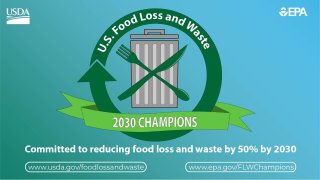United States 2030 Food Loss and Waste Reduction Goal
Reducing food waste presents opportunities to:
- Address climate change;
- Increase food security, productivity and economic efficiency; and
- Conserve energy and other resources.
In the U.S., 30 to 40 percent of the food supply is never eaten, wasting the resources used to produce it and creating many environmental impacts. Food waste is the single most common material landfilled and incinerated in the U.S.
More than 85 percent of greenhouse gas emissions from landfilled food waste result from activities prior to disposal, including production, transport, processing, and distribution.1 In order to reduce these emissions, we need to prevent food waste from being generated in the first place.
- U.S. 2030 Food Loss and Waste Reduction Goal
- Measuring the Success of the Goal
- Current Progress Toward the Goal
- How Does EPA Plan to Take Action on the Goal?
- How Can You Take Action?
U.S. 2030 Food Loss and Waste Reduction Goal
On September 16, 2015, the U.S. Department of Agriculture (USDA) and EPA announced the U.S. 2030 Food Loss and Waste Reduction goal, the first-ever domestic goal to reduce food loss and waste. The goal seeks to cut food loss and waste in half by the year 2030.
By acting on this goal, the U.S. can reduce climate and environmental impacts associated with food loss and waste while improving food security and saving money for families and businesses.
EPA, USDA, and the Food and Drug Administration (FDA) form a Federal Interagency Collaboration to Reduce Food Loss and Waste, and together work with communities, organizations and businesses, along with our partners in state, Tribal and local government, to take actions that will lead us closer to achieving the national goal.
Measuring the Success of the Goal
To measure and describe progress toward the 2030 food loss and waste reduction goal, the following baseline is being used:
- For food waste in the United States: EPA estimates the amount of food waste generated by sector, as well as the amounts being managed by several management pathways. In September 2021, EPA updated the baseline to align the 2030 goal with the United Nations’ Sustainable Development Goal (SDG) Target 12.3, which aims to reduce the amount of food from food retail, food service, and households that has been removed from the human supply chain. This is defined as food waste that is being sent to the following six management pathways: landfill; controlled combustion; sewer; litter, discards and refuse; co/anaerobic digestion; compost/aerobic digestion; and land application.2 With this updated approach and baseline, in 2016, 328 pounds of food waste per person were sent to landfill, controlled combustion, sewer, co/anaerobic digestion, compost/aerobic digestion, and land application. The 2030 goal aims to reduce this food waste by 50 percent to 164 pounds per person.
- For food loss in the United States: EPA and USDA do not have a baseline for food loss, which occurs in production and up to (but not including) the retail level.
Current Progress Toward the Goal
The U.S. still has a long way to go to meet the 2030 goal. For food waste, the goal aims to reduce the amount of food leaving the human food supply chain by 50% by 2030. It aims to prevent food waste generation in the first place, which is important from a climate perspective, since the majority of greenhouse gases from food waste are created before the food goes to disposal. In 2018, 335 pounds of food waste per person left the human food supply chain (i.e., were sent to landfill, controlled combustion, sewer, co/anaerobic digestion, compost/aerobic digestion, and land application), and in 2019, 349 pounds of food waste per person left the human food supply chain. In the three years between the baseline year (2016) and the latest estimates (2019), there was a six percent increase in per capita food leaving the human supply chain (i.e., food waste going to the six identified management pathways).3 EPA and USDA do not have baselines for food loss and at this time are not able to measure progress toward this part of the national and international goals.
How Does EPA Plan to Take Action on the Goal?
Working with USDA, FDA, and state and Tribal partners, EPA plans to secure action on the 2030 goal by working with leaders in the food system (e.g., private, government, non-profit, academia, faith) to promote successful interventions and tools to advance the sustainable management of food.
By aligning the national goal with SDG Target 12.3, we are challenging everyone to prevent food waste from being generated in the first place, keep food in the human supply chain, and recycle anything remaining.
How Can You Take Action?
Everyone can take action to reduce food loss and waste in the United States, whether you are an individual, a business, a school, or a non-profit, community or faith-based organization.
- Individuals and Communities: If you are an individual, learn how to prevent wasted food at home. Communities can learn how to help households with the Food: Too Good to Waste Toolkit.
- Businesses and Organizations: If you are a business, you can begin by measuring your food waste and then taking action to reduce it. Consider joining the U.S. Food Loss and Waste Champions. Check out EPA’s tools for preventing and diverting wasted food and resources in our Model Recycling Toolkit.
- Faith Organizations: If you are a faith organization, take a look at our Food Stewards Toolkit.
1 U.S. EPA. Documentation for Greenhouse Gas Emission and Energy Factors Used in the Waste Reduction Model (WARM) Organic Materials Chapters (pdf). (2020).
2United Nations Environment Programme’s Food Waste Index Report, which provides detail on how countries are expected to measure against SDG 12.3.

